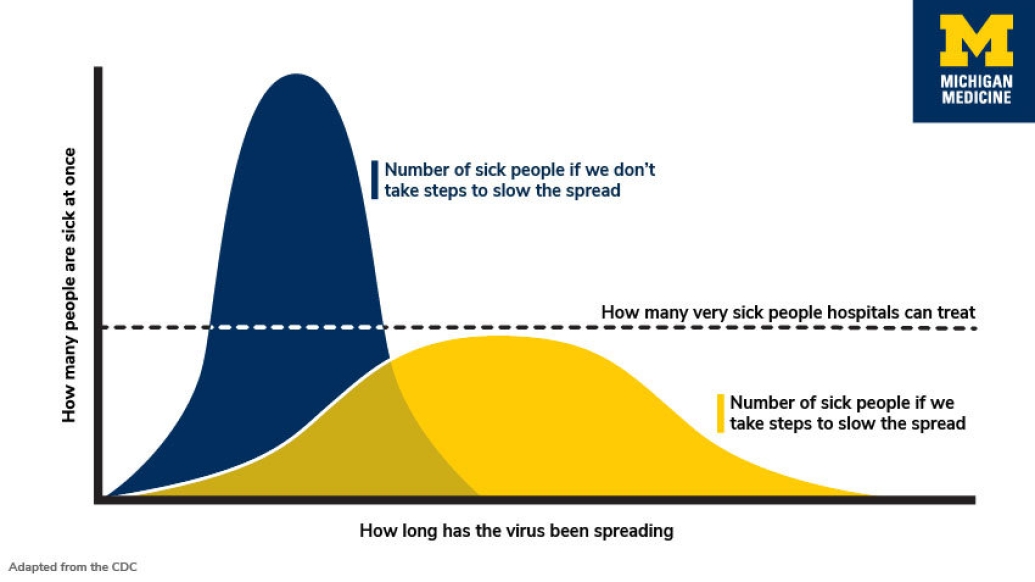History shows that taking strong steps now to slow the spread of coronavirus will help communities and individuals.
1:47 PM
Author |

Versión en español. Leia este artigo em português.
Editor's note: Information on the COVID-19 crisis is constantly changing. For the latest numbers and updates, keep checking the CDC's website. For the most up-to-date information from Michigan Medicine, visit the hospital's Coronavirus (COVID-19) webpage.
Interested in a COVID-19 clinical trial? Health research is critical to ending the COVID-19 pandemic. Our researchers are hard at work to find vaccines and other ways to potentially prevent and treat the disease and need your help. Sign up to be considered for a clinical trial at Michigan Medicine.
Cruises and flights canceled. Colleges and universities sending students home to watch lectures online. Public schools closing. Offices asking people to telecommute. Concerts, parades, festivals and sporting events postponed.
Is all of this really necessary for the coronavirus? Are public health officials overreacting to the threat posed by the virus that causes the disease COVID-19?
It's absolutely necessary, because it's worked in the past, says medical historian Howard Markel, M.D., Ph.D., a University of Michigan expert who has studied the effects of similar responses to past epidemics.
"An outbreak anywhere can go everywhere," he says. And right now, "We all need to pitch in to try to prevent cases both within ourselves and in our communities."
It's called "flattening the curve," a term that public health officials use all the time but that many Americans just heard for the first time this week.
SEE ALSO: Think This Flu Season Is Bad? Flash Back 100 Years
What curve? And why is flatter better?
If you look at the image above, you can see two curves – two different versions of what might happen in the United States, depending on next steps.
The tall, skinny curve is bad – it means that a lot of people will get sick at once, in a short period of time because we don't take enough steps to prevent the virus from spreading from person to person.
Most people won't get sick enough to need a hospital. But those who do could overwhelm the number of beds and care teams that our nation's hospitals have available.
MORE FROM MICHIGAN: Sign up for our weekly newsletter
After all, Markel points out, many emergency rooms and hospitals already operate close to capacity on a good day, without coronavirus. Adding a sharp spike in very ill COVID-19 patients to that traffic could mean some people don't get the care they need – whether they have coronavirus or not.
An outbreak anywhere can go everywhere. We all need to pitch in to try to prevent cases both within ourselves and in our communities.Howard Markel, M.D., Ph.D.
The flatter, lower curve is a much better one – but it will take working together to make it happen, says Markel, who's the director of the Center for the History of Medicine at the U-M Medical School.
Like Podcasts? Add the Michigan Medicine News Break to your Alexa-enabled device or subscribe for daily updates on iTunes, Google Play and Stitcher.
He and his colleagues have studied the effects of efforts to stop the spread of the 1918 flu pandemic and the 2009 H1N1 flu epidemic.
Flattening it together helps everyone
If individuals and communities take steps to slow the virus's spread, that means the number of cases of COVID-19 will stretch out across a longer period of time. As the curve shows, the number of cases at any given time doesn't cross the dotted line of the capacity of our nation's health care system to help everyone who's very sick.
"If you don't have as many cases coming to the hospitals and clinics at once, it can actually lower the number of total deaths from the virus and from other causes," he says. "And, importantly, it buys us time for university and government scientists, and industry, to create new therapies, medications and potentially a vaccine."
Another key factor to consider: the doctors, nurses, pharmacists, technicians and many other staff who actually work in healthcare. The more cases of COVID-19 there are at any given time, the more likely some of them are to catch it, whether in the community or at work. Once they're sick, they need to stay away from patients for weeks. Which means fewer people to take care of the patients who need care.
The bottom line
Canceling, postponing or moving online for our work, education and recreation may be inconvenient, annoying and disappointing.
But hospitals need to have enough room, supplies and staff to care for those who need hospital-level care -- whether it's for coronavirus, a heart attack, car crash, broken bone or birth. That's why it's important to listen to public health authorities and leaders if and when they say it's time to change how we live our lives temporarily.
"Coronavirus is a socially transmitted disease, and we all have a social contract to stop it," says Markel. "What binds us is a microbe – but it also has the power to separate us. We're a very small community, whether we acknowledge it or not, and this proves it. The time to act like a community is now."
For the most updated information from Michigan Medicine about the outbreak, visit the hospital's Coronavirus (COVID-19) webpage.

Explore a variety of health care news & stories by visiting the Health Lab home page for more articles.

Department of Communication at Michigan Medicine
Want top health & research news weekly? Sign up for Health Lab’s newsletters today!





